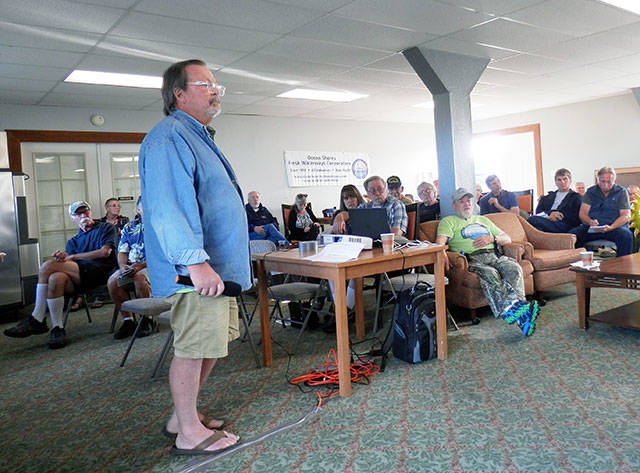The leading expert on the health and the state of Ocean Shores’ fresh waterways gave his annual report on Saturday to a group of about 60 people at the Fresh Waterways Corp. “Wine and Weeds” gathering.
“We have been working in Ocean Shores a very long time,” said Doug Dorling of Northwest Aquatic Ecosystems, which has been monitoring and treating the inland canals and lakes since 2009. “And we have been pretty aggressive these last three years.”
Dorling gave a historical perspective to the treatment program, which began with efforts to control Brazilian elodea. “At the time that treatment was made, it was nearly impossible to get a boat through Duck Lake,” Dorling said. In 2009-2010, grass carp were then planted in the waterways to also try to control the weeds with a natural method that still remains somewhat controversial, he added.
In 2011, a survey of the entire lake system was completed, followed by another survey in 2014, and the city in 2015 then began “to really get fairly aggressive in trying to control the week problem,” according to Dorling.
For the next three years, Dorling’s firm was hired to treat the waterways with herbicides.
Using sonar imaging, the company can actually determine where weeds are located and map the areas of greatest growth.
Before treatment this past year, many of the so-called finger canals were fairly well infested with weeds, the mapping showed.
All of the survey data was placed on one map, and the place with the highest concentration was at the north end of the Grand Canal.
“We take this map and then we determine the areas we want to treat,” Dorling said of how this summer’s treatment areas were determined.
One of the key concerns was the increase infestation of the weed pennywort, which grows along the shoreline and encroaches into the main body of water. Also, there is duckweed, another fast-spreading aquatic weed, and parrotfeather, which Dorling described as a “really aggressive noxious weed.”
“The only problem area we ran into this year were these four or five finger canals off Duck Lake. They are really shallow,” Dorling said. The idea is to try a different material next year to treat those areas.
“We may not be able to control all the weeds that are in there, but we we will probably be able to control at least 50 percent of them,” he said.
The good news is that parrotfeather appears to have decreased by about 85 percent over the past three years of treatment, according to Dorling. “So I know we are well on the way to eradicating that one from the shores of Ocean Shores,” he said.
Most of the product used in the treatment is Diquat Dibromide for submersed weeds; Imazapyr and Triclopyr also are used for floating weeds such as pennywort and parrotfeather.
“One of the questions we always get is what are we putting in the lake and what are the health risks associated with it?” Dorling said.
For Diquat, he said there were no swimming restrictions associated with its use, but a potable water restriction of three days, and no use for food crop irrigation for three days.
When the sprayings are done, Dorling said, they post the restrictions along with a 24-hour swimming advisory. He also showed a chart that listed Diquat as having less toxicity than chlorine, nicotine or coffee.
Dorling urged the city to continue to fund the treatments year after year to keep up the success of the past three years, as well as a spring survey to determine where best to treat the waterways.
“You want to treat early in the season because as these plants grow, all the vegetative material is biomass,” Dorling said.
“So if you treat these plant growths early in the season, you will have less biomass that’s going to sink to the bottom of the lake and decompose” and cause the potential for an algae bloom.



